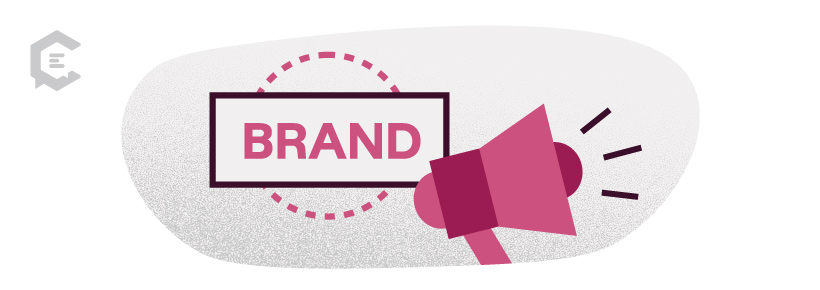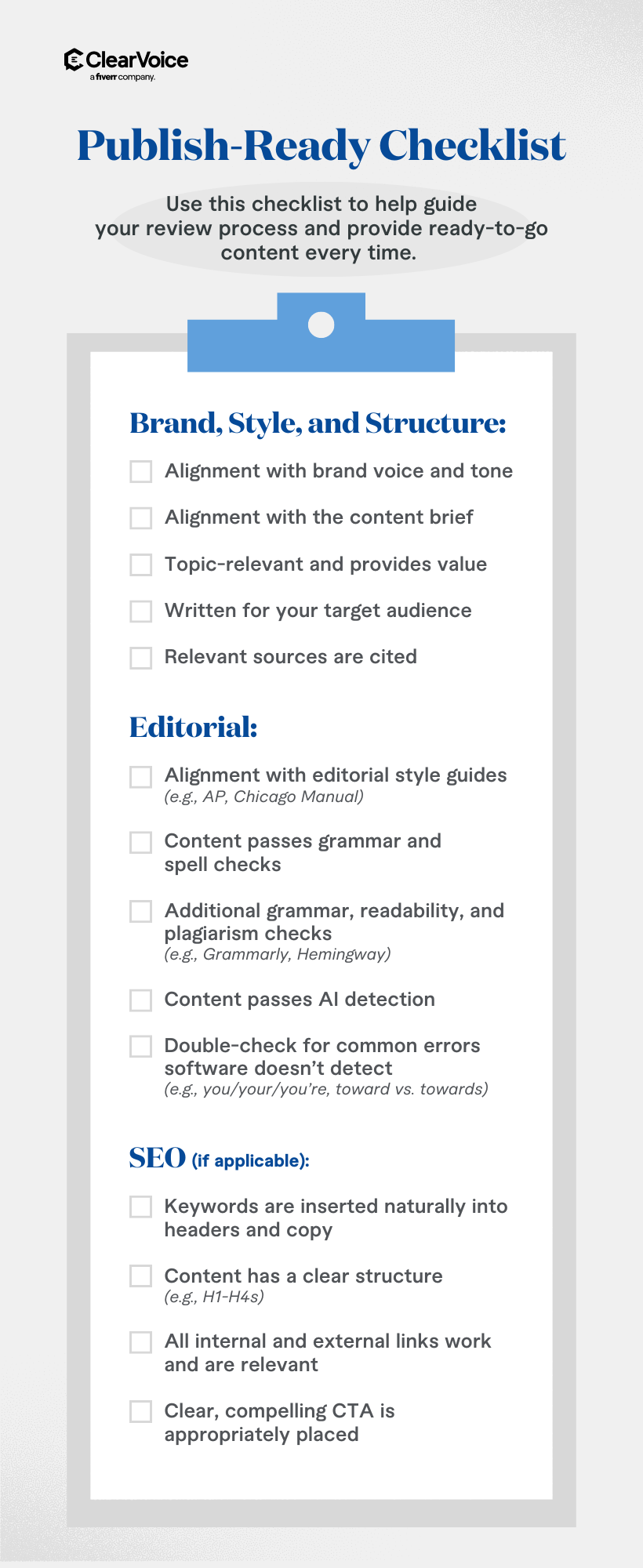Quality content isn’t just the backbone of a great marketing strategy — it’s your ticket to standing out in a sea of information. It’s not just about catching your audience’s eye; top-notch content gets the nod from search engines, racks up shares on social media, and turns leads into responses.
Solid content does more than just fill space; it builds bridges between brands and audiences. A truly great piece of content boosts your credibility, ramps up trust, and sparks engagement.
But let’s be real; consistently knocking it out of the park with high-quality content is no small feat. That’s where tools like a publish-ready checklist come into play, helping you hit the mark every single time and keep your audience coming back for more.
Understanding the Publish-Ready Checklist
A publish-ready checklist acts as a guardrail for new content. It ensures that every piece of content — no matter who writes or edits it — is consistent in style, voice, and messaging before going live.
A checklist outlines different quality markers that need to be met before publishing. These should always include checking for:
- Spelling and grammar
- Brand-specific requirements (i.e., trademarks)
- Legal compliance issues
- Layout and structure
- Multimedia requirements
- Plagiarism or AI usage
Additionally, a checklist may include requirements to ensure content aligns with your audience, values, or goals.
Why Use a Checklist
Ultimately, a checklist ensures you deliver quality content every time. It gives your writers and editors a clear set of goals and reminders to keep in mind throughout the content creation process.
A checklist can help your content team pinpoint where things might be slipping through the cracks, figuring out what went wrong, and how to fix it. This means not just better content now, but a smoother process and improved results every time you hit ‘publish’.
Components of a Publish-Ready Checklist
What you choose to include in your publishing checklist should be unique to your business. One of the core components of quality content is a clear tone of voice and point of view.
“You have to separate yourself from the competition. You have to be more appealing to your target audience, and you can achieve it by creating a recognizable personal brand.” – Neil Patel
Ensuring brand consistency helps build your personal brand and following. So, when putting together a checklist, think closely about what defines your brand. Still, there are some common frameworks to include and tailor to your business.
Content Quality Assurance
“Your grammar is a reflection of your image. Good or bad, you have made an impression. And like all impressions, you are in total control.” – Jeffrey Gitomer
All content quality checklists should include reminders to follow grammar, spelling, and style guides. Some questions may include:
- Did you perform a thorough grammar and spelling check? Did you cross-reference the editorial style guide and provided style (i.e., AP, Chicago, etc.)?
- Did you check for common errors that may slip a traditional check, such as their/they’re/there, you/your/you’re, toward vs. towards, etc.?
- Did you use Grammarly and Hemingway for additional checks as a secondary set of eyes for grammar, spelling, overall readability, and plagiarism?
- Does the cultural and linguistic approach align with the guidance in the brand profile?
Additionally, you should check that the content is serving its designed purpose.
- Does the content offer a unique and engaging perspective of the topic, offering value beyond the surface?
- Does it offer a different approach or expand the topic beyond what is easily searchable online?
- Does the content align with the depth of guidance provided in the brief and brand profile?
- Do the relevant facts and assertions contain proper sourcing per the brand guidelines and customer preferences/requirements?
- Is there any irrelevant content or points that could be removed, condensed, or listed with bullet points (especially when the piece is over word count)?
Consistency and Brand Compliance
Your brand needs a clear voice style guide. It spells out your overall tone and might even dive into specific words that do — or don’t — jive with your core values and mission. Every piece of content should echo your brand voice, loud and clear. To make sure this remains consistent, include checklist questions like:
- Does the content reflect the brand’s tone and voice throughout?
- Does the piece have the correct language, style, and additional client nuances throughout?
- Will this piece sound consistent across all platforms, from social media to emails?
SEO and Readability Optimization
“Good SEO is paying attention to all the details that most bloggers ignore.” – Ryan Biddulph
Not all content is expressly for search engine optimization. But all SEO comes from good content.
Your content quality checklist should look for SEO best practices and the technical components of good user experience. Ask:
- Does the content have a clear structure (e.g., introduction, body, and conclusion, including H2-H4s)?
- Does the content flow logically through its sections and beyond just the headers?
- Are the relevant keywords woven naturally into the headers and the main text?
- Do all the internal and external links add value? Are they in line with brand guidelines about sources, fully functional, and do they lead to the correct pages?
Multimedia Integration
Gone are the days of content marketing, which only included blogs. Successful brands blend traditional content with multimedia elements to great success. For example, Whole Foods Market mixes blog content with multimedia elements like cooking videos and social posts. They also feature infographics and explainers on nutrition and wellness topics.
Blending multimedia elements into your content can be a smart decision, but comes with its own quality assurance issues. If applicable, check that:
- Images meet the required file size and recommended dimensions
- Social posts embed correctly and don’t break the visual flow of the page
- Multimedia components add value to the content
- Your content and multimedia are accessible
- You have the appropriate royalties or permissions to use multimedia content
Legal and Compliance Checks
A great piece of content should be useful, accurate, and insightful. So, avoiding legal issues with the Federal Trade Commission shouldn’t be hard. Still, it’s important to bake legal questions into your publish-ready checklist. Some questions may include:
- Does the content include registered trademarks or other brand names?
- Does the content use the copyright or intellectual property rights of others? This includes images, videos, music, and written content.
- Do any statements need disclaimers?
Additionally, some industries have specific regulations governing advertising and marketing practices. For instance, healthcare, financial services, and alcohol industries often have stringent rules. Higher education needs to check they aren’t making false promises. Wellness companies need to avoid making drug claims. Consult with your legal team and develop specific items to check off before publishing new content.
Team Collaboration and Approval Processes
It’s rare for content to touch only one team member before it goes live. A publish-ready checklist can document the process of a piece of content going from idea to URL.
Your checklist should outline the timeline and pinpoint when content should pass from one team member to the next. For instance, a writer finishes the initial quality checks, then an editor takes a look to make sure it aligns with the content brief, and finally, a reviewer gives it the green light for publishing.
This flow might tweak a bit depending on your team’s setup and needs, but having it documented ensures consistency every time.
Customizing Your Own Checklist
As we’ve said before, not every business is cut from the same cloth. Your content should reflect what’s unique about your services, values, and goals. So, it makes sense that an effective content checklist should also be unique to your business.
While some components — like spelling, grammar, and legal compliance — should be standard, expand these baseline suggestions to suit your needs. Rely heavily on social media? Add some pointers for crafting connected posts. In a tightly regulated field? Include extra steps for expert review. Shape that checklist to really work for you.
And if, at any point, the content checklist isn’t creating publish-ready pieces, revisit the process. If an assignment goes sideways, review the checklist against the feedback and determine where things broke down. Keep your checklist dynamic — a living document that you tweak and improve as you go.
Here’s our go-to, publish-ready checklist for easy access:
Brand, Style, & Struture:
- Is the piece aligned with the brand voice and tone?
- Is the piece aligned with the content brief?
- Is the piece topic-relevant, and does it provide value?
- Is it written for your target audience?
- Are relevant sources cited?
Editorial:
- Is the piece aligned with your editorial style guides? (e.g., AP Style, Chicago Manual, etc.)
- Does the content pass grammar and spell checks?
- Have you completed additional grammar, readability, and plagiarism checks? (e.g., Grammarly, Hemingway, etc.)
- Does the piece pass AI detection tools?
- Have you double-checked for common errors that software doesn’t always detect? (e.g., you/your/you’re, toward vs. towards, etc.)
SEO (if applicable):
- Are keywords inserted naturally into headers and body copy?
- Does the content have a clear structure? (e.g., H1-H4s)
- Are all internal and external links working and relevant?
- Is there a clear, compelling CTA appropriately placed?
Create Publish-Ready Content, Every Time
A quality content framework helps guide in-house and freelance editors to ensure consistency and meet our expectations across every assignment. It means you can consistently further your marketing goals no matter who handles your content.
If you’re struggling to determine where your content is losing consistency or have more questions about how to streamline your content process, connect with a content specialist to help meet your goals.













